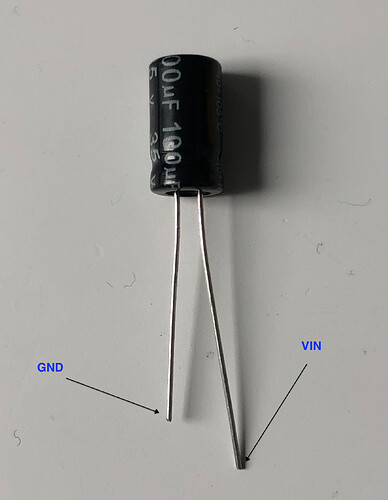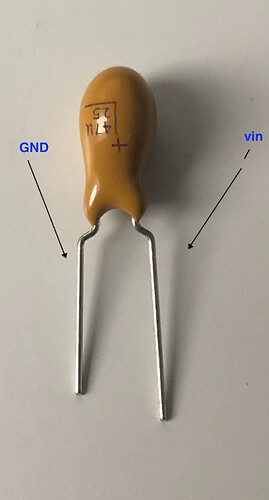Hi I have a problem.
My blynk app disconnects with esp32 or refuses to connect. I supply power to esp32 and other things and when esp32 works on this supply it does not connect. But if I disconnect vin from esp32 and supply power only to it via micro usb cable, it works. Then I connect it to the normal power supply and it’s still connected to micro usb and it works. When I remove micro usb it works for 10 mins and then stops working (disconnects) (led on it still shines).
Here’s code:
float MaxTemp = 0;
int MaxMoist = 0;
int MinMoist = 0;
int x = 0;
float temperatureIN = 0;
#include <Adafruit_Sensor.h>
#include "Adafruit_TSL2591.h"
Adafruit_TSL2591 tsl = Adafruit_TSL2591(2591);
#define pump 26
int ElFan = 12;
int PlFan = 32;
int soilMoisture = 0;
int soilMoistureSensor = 34;
int gBright = 0;
int rBright = 213;
int bBright = 42;
#include <analogWrite.h>
#define RED_LED 14
#define BLUE_LED 19
#define GREEN_LED 27
#define BLYNK_PRINT Serial
#include <WiFi.h>
#include <WiFiClient.h>
#include <BlynkSimpleEsp32.h>
char ssid[] = "****";
char pass[] = "-----;
char auth[] = "pass";
BlynkTimer timer;
boolean stateled=0;
boolean prevStateled=0;
#define BLYNK_MSG_LIMIT 20
#include <OneWire.h>
#include <DallasTemperature.h>
float tempC = 0;
// Data wire is plugged into port 2 on the Arduino
#define ONE_WIRE_BUS 15
// Setup a oneWire instance to communicate with any OneWire devices
OneWire oneWire(ONE_WIRE_BUS);
// Pass our oneWire reference to Dallas Temperature.
DallasTemperature sensors(&oneWire);
// Addresses of 3 DS18B20s
uint8_t sensor1[8] = { 0x28, 0xFF, 0xCD, 0xAC, 0x02, 0x19, 0x8A, 0xDE };
uint8_t sensor2[8] = { 0x28, 0xFF, 0xED, 0xAD, 0x02, 0x19, 0x8A, 0xA9 };
void printTemperature(DeviceAddress deviceAdress){
}
BLYNK_READ(V2) {
Blynk.virtualWrite(2,analogRead(soilMoistureSensor)/37);
}
BLYNK_READ(V1) {
Blynk.virtualWrite(1,tsl.getLuminosity(TSL2591_VISIBLE));
}
BLYNK_READ(V3) {
float tempC = sensors.getTempC(sensor1 );
Blynk.virtualWrite(3, tempC);
}
BLYNK_WRITE(V4)
{
MinMoist = param.asInt();
if ( analogRead(soilMoistureSensor)/37< MinMoist){
digitalWrite(pump,HIGH);
}
}
BLYNK_WRITE(V7) {
MaxMoist = param.asInt();
if(analogRead(soilMoistureSensor)/37 > MaxMoist) {
digitalWrite(pump,LOW);
}
}
BLYNK_WRITE(V8) {
MaxTemp = param.asInt();
if(sensors.getTempC(sensor1 ) > MaxTemp){
digitalWrite(PlFan,HIGH);
}
else {
digitalWrite(PlFan, LOW);
}
}
void simpleRead(void)
{
// Simple data read example. Just read the infrared, fullspecrtrum diode
// or 'visible' (difference between the two) channels.
// This can take 100-600 milliseconds! Uncomment whichever of the following you want to read
uint16_t x = tsl.getLuminosity(TSL2591_VISIBLE);
//uint16_t x = tsl.getLuminosity(TSL2591_FULLSPECTRUM);
//uint16_t x = tsl.getLuminosity(TSL2591_INFRARED);
Serial.print(F("[ ")); Serial.print(millis()); Serial.print(F(" ms ] "));
Serial.print(F("Luminosity: "));
Serial.println(x, DEC);
}
void setup(void)
{
pinMode(PlFan, OUTPUT);
configureSensor();
pinMode(ElFan, OUTPUT);
sensors.begin();
pinMode(soilMoistureSensor, INPUT_PULLUP);
pinMode(pump, OUTPUT);
// Debug console
Serial.begin(115200);
pinMode(13,OUTPUT); // NODEMCU PIN D7
Blynk.begin(auth, ssid, pass, "blynk-cloud.com", 8442);
timer.setInterval(300L, checkledstate);
// attachInterrupt(digitalPinToInterrupt(13), notifyOnled, CHANGE);
}
BLYNK_WRITE(V6)
{
if (param.asInt()){
analogWrite(GREEN_LED, gBright);
analogWrite(RED_LED, rBright);
analogWrite(BLUE_LED, bBright);
Blynk.virtualWrite(V13,1);
} else {
analogWrite(GREEN_LED,0);
analogWrite(RED_LED, 0);
analogWrite(BLUE_LED, 0);
Blynk.virtualWrite(V13,0);
}
}
void loop(){
simpleRead();
ElWent();
sensors.requestTemperatures();
if (Blynk.connected())
{
Blynk.run();
}
timer.run();
}
BLYNK_CONNECTED()
{
Blynk.syncVirtual(V6);
}
void checkledstate()
{
stateled=digitalRead(13);
if (stateled!=prevStateled)
{
if (stateled==0) Blynk.virtualWrite(V13,0);
if (stateled==1) Blynk.virtualWrite(V13,255);
}
prevStateled=stateled;
}
void ElWent (){
if(temperatureIN >= 35) {
digitalWrite(ElFan, HIGH);
}
else{
digitalWrite(ElFan, LOW);
}
}void configureSensor(void)
{
// You can change the gain on the fly, to adapt to brighter/dimmer light situations
//tsl.setGain(TSL2591_GAIN_LOW); // 1x gain (bright light)
tsl.setGain(TSL2591_GAIN_MED); // 25x gain
//tsl.setGain(TSL2591_GAIN_HIGH); // 428x gain
// Changing the integration time gives you a longer time over which to sense light
// longer timelines are slower, but are good in very low light situtations!
//tsl.setTiming(TSL2591_INTEGRATIONTIME_100MS); // shortest integration time (bright light)
// tsl.setTiming(TSL2591_INTEGRATIONTIME_200MS);
tsl.setTiming(TSL2591_INTEGRATIONTIME_300MS);
// tsl.setTiming(TSL2591_INTEGRATIONTIME_400MS);
// tsl.setTiming(TSL2591_INTEGRATIONTIME_500MS);
// tsl.setTiming(TSL2591_INTEGRATIONTIME_600MS); // longest integration time (dim light)
/* Display the gain and integration time for reference sake */
Serial.println(F("------------------------------------"));
Serial.print (F("Gain: "));
tsl2591Gain_t gain = tsl.getGain();
switch(gain)
{
case TSL2591_GAIN_LOW:
Serial.println(F("1x (Low)"));
break;
case TSL2591_GAIN_MED:
Serial.println(F("25x (Medium)"));
break;
case TSL2591_GAIN_HIGH:
Serial.println(F("428x (High)"));
break;
case TSL2591_GAIN_MAX:
Serial.println(F("9876x (Max)"));
break;
}
Serial.print (F("Timing: "));
Serial.print((tsl.getTiming() + 1) * 100, DEC);
Serial.println(F(" ms"));
Serial.println(F("------------------------------------"));
Serial.println(F(""));
}
please help
Maciek

 .
.
